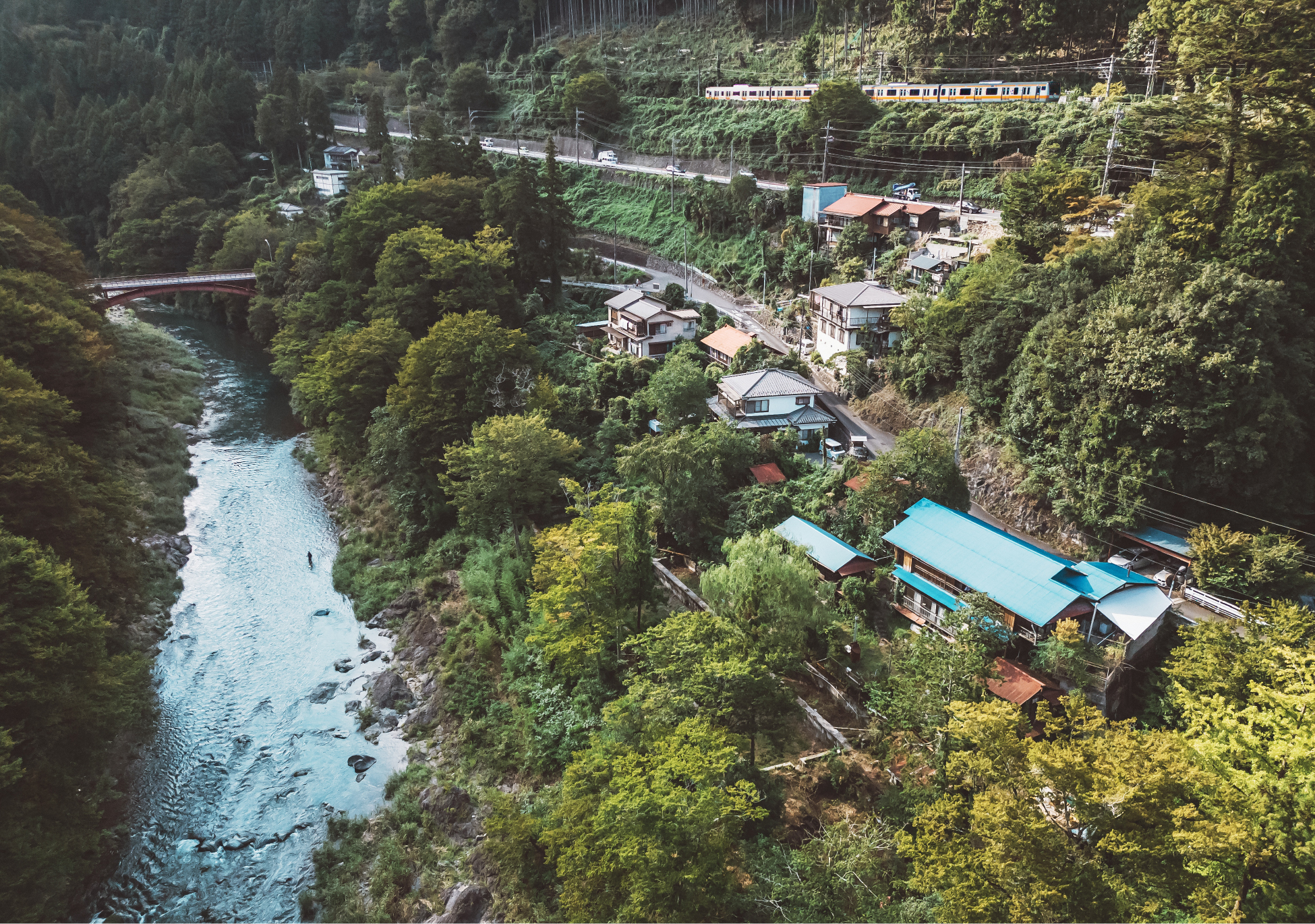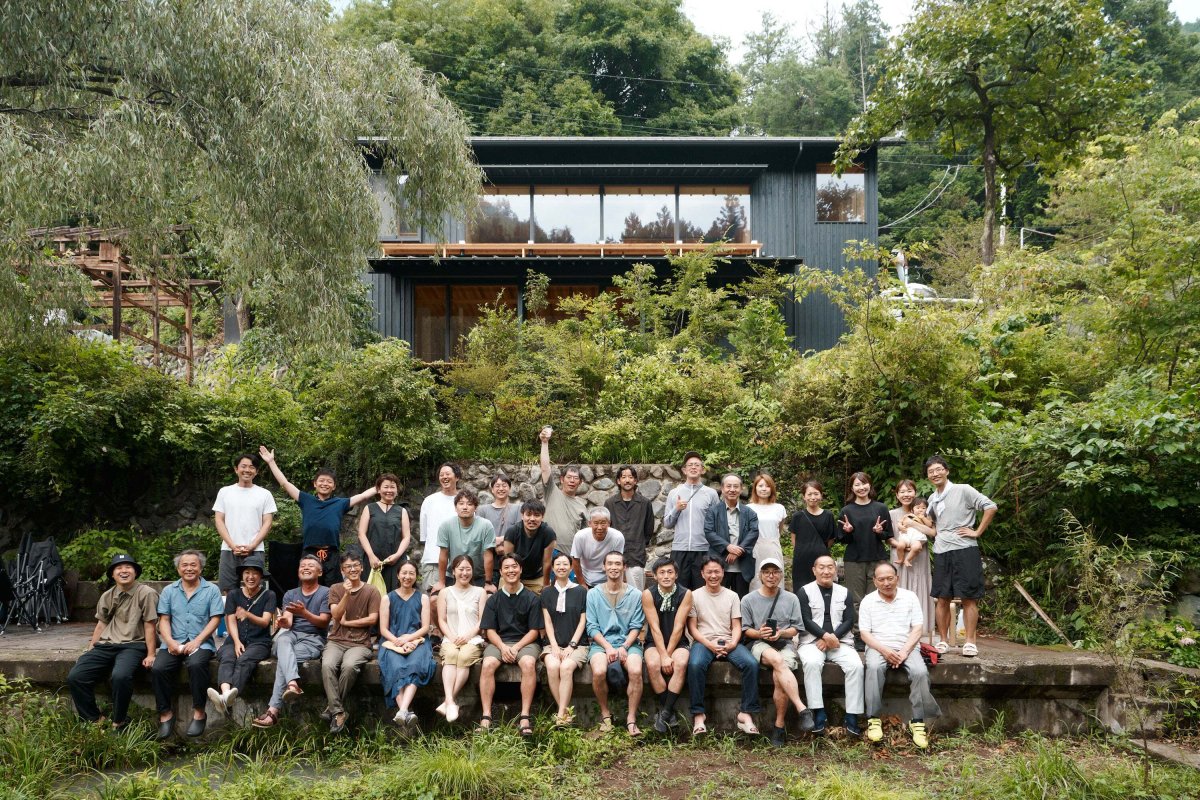
Recognizing that the shift to sustainability will depend not only on high-tech solutions and tentpole projects, the Newsweek Japan SDGs Awards (aligned with the United Nations‘ Sustainable Development Goals) were launched in 2023, aiming to shine a light on Japanese companies working in this space. Ensen Marugoto Hotel Project, an innovative take on regional revitalization, took the top prize at the 2024 awards, presented at a ceremony in March.
Tokyo, but Not as We Know It
Running out to the westernmost district of Tokyo, the JR Ome Line terminates in Okutama. Though technically part of the Japanese capital, it is a world away from the skyscrapers of the megalopolis, brimming with nature, wildlife and spectacular vistas. It is also a microcosm of many of the challenges facing rural Japan. Okutama’s population is down two-thirds from its 15,000 postwar peak, young people have moved closer to the city center and houses lie empty, raising questions as to the railway line’s viability. A joint venture born out of East Japan Railway Company (JR East, the operator of the Ome Line) and Satoyume (a local business incubator), the Ensen Marugoto Hotel Project takes a multipronged approach to addressing these issues.
Ensen Marugoto translates as “along the whole railway line,” the idea being that the entire area becomes a hotel. An unmanned station now acts as the hotel’s reception, where guests check in before being shown by a local resident to a renovated traditional Japanese minka house, which serves as their accommodation.
“Creating a business that is rooted in the community, that makes full use of its existing resources and doesn’t require huge investment,” is central to the concept, explains Hitoshi Aida, a director at Ensen Marugoto Co.
Village Tales
To that end, a restaurant and sauna opened in May 2024, in what had been a vacant 130-year-old minka. Known as Satologue, a portmanteau of the Japanese word for village/countryside, and “logue,” in the sense of a dialogue, it also fully utilizes local resources. With the area once home to a thriving forestry industry, the sauna is wood-fired. Meanwhile, dishes at the restaurant brim with local ingredients, including wasabi, an Okutama specialty that is grown a stone’s throw away. However, the young chef and manager have relocated from the city, a welcome injection of fresh faces into the district.
Responses from the approximately 5,000 customers who have visited since its opening have been extremely positive, according to Aida, who reports that work has just finished on a new four-room hotel in the Satologue grounds.
Older Okutama residents act as guides, sharing their knowledge with visitors.
“Some were unsure if they would be able to do this type of work. But after getting great feedback from guests, they have grown in confidence and realized they know about things that are not in any guidebooks,” explains Aida.

Mobile Solutions
To help visitors get around the district, which is hilly in places and not served by many buses, Ensen Marugoto has partnered with a mobility startup to provide electric tuk-tuks and sports bikes. These have proved a big hit with guests, many of whom are young.
“Rather than island-hopping, in Okutama, we talk about village-hopping,” says Aida.
The project has also attracted an unexpectedly large number of overseas visitors, surprising given that it has so far targeted the domestic market and its website is only in Japanese (work is currently underway on English pages).
“By this winter, around 20 percent of our guests were from abroad. It seems many people find us through online searches or social media once they get to Tokyo,” reports Aida.
Spreading the Tourist Love
Japan is experiencing an unprecedented inbound boom, leading to overtourism problems in the most popular spots, something Aida believes the project can contribute to solving. To put the current situation in context, 10.5 million tourists arrived in the first three months of 2025, more than visited Japan in the whole of 2013. The majority flock to the same areas of Tokyo, Osaka and Kyoto, causing overcrowding and putting pressure on accommodation and transportation infrastructure.
If a small portion of these visitors were to travel further afield to places like Okutama, it would ease congestion, provide them with new experiences and boost local economies struggling with depopulation.
“It really is a win-win situation,” suggests Aida.
Ensen Marugoto is in the process of securing five more vacant minka along the Ome Line and plans to transform them into leisure and accommodation facilities. And more than a dozen districts around Japan have been in touch to discuss implementing similar projects.
The aim is to have revitalization underway in around 30 areas alongside train lines with similar profiles to Okutama by 2040, making a significant contribution to solving multiple social challenges.
“I also hope that this can be a model for other developed countries around the world that are experiencing the same types of issues around depopulation and aging societies,” adds Aida.
This report has been paid for by a third party. The views and opinions expressed are not those of Newsweek and are not an endorsement of the products, services or persons mentioned.
